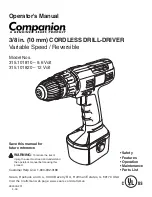
7 - English
WARNING:
Make sure to insert the drill bit straight into the chuck jaws.
Do not insert the drill bit into the chuck jaws at an angle,
then tighten. This could cause the drill bit to be thrown
from the drill, resulting in possible serious personal injury
or damage to the chuck.
Rotate the chuck sleeve to close and tighten the chuck
jaws.
WARNING:
Do not hold the chuck sleeve with one hand and use the
power of the drill to tighten the chuck jaws on the drill bit.
The chuck sleeve could slip in your hand, or your hand
could slip and come in contact with the rotating drill bit.
This could cause an accident resulting in serious personal
injury.
To remove bits,
lock the switch trigger and open the
chuck jaws.
The bit provided with the drill can be placed in the storage
area, located on the base of the drill.
TWO-SPEED GEAR TRAIN
See Figure 6, page 12
.
Select
low speed
(1)
for applications such as drilling in
metal, and for applications requiring higher torque, such
as driving large screws.
Select high
speed
(2)
for fast drilling or driving applications,
for drilling in wood or masonry, and for hammer drilling.
OPERATION
NOTICE:
Never change speeds while the tool is running. Failure to
obey this caution could result in serious damage to the
drill.
NOTE:
If you have difficulty changing from one speed range
to the other, turn the chuck by hand until the gears engage.
MODE SELECTOR
See Figure 7, page 12.
The mode selector allows you to quickly switch from drill
mode to drive mode.
Drill mode should be used for drilling and other heavy duty
applications. Drive mode should be used for driving screws.
Hammer mode should be used for hammer drilling.
Using the chart, select the option that best matches the type
of bit, fastener, and material you will be using.
Choose your
APPLICATION.
Choose the correct
SPEED: (1/LOW OR 2/HIGH)
Choose the correct
MODE: (DRIVE, DRILL, OR
HAMMER)
ADJUSTING TORQUE
See Figure 8, page 12.
When using the drill-driver for various driving applications,
increasing or decreasing the torque helps prevent the pos
-
sibility of damaging screw heads, threads, workpiece, etc.
In general, torque intensity should correspond to the screw
diameter. If the torque is too high or the screws too small,
the screws may be damaged or broken.
APPLICATION
SPEED
MODE
• Lag screws up to 3/8 in. dia. by 1-1/2 in. long
• Hole saw up to 2 in.
• Spade bits up to 1-1/2 in.
• Drill bits up to 1/2 in.
• Drilling into metal
• Concrete screws
1/LOW
DRILL MODE
(TORQUE ADJUSTMENT
NOT ACTIVE)
2/HIGH
• Deck or wood screws up to 3 in.
• Self tapping screws
1/LOW
DRIVE MODE
• Deck or wood screws up to 2 in.
• Small screws or delicate work that requires more control
2/HIGH
• Drilling into masonry and concrete.
2/HIGH
HAMMER MODE
(TORQUE ADJUSTMENT
NOT ACTIVE)








































